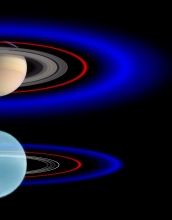|

Press Release 06-057
A Blue Ring Around the Planet Uranus

Color is attributed to forces acting on dust
April 6, 2006
The outermost ring of the planet Uranus turns out to have a bright blue color, according to a report in the April 7 issue of the journal Science. That makes it only the second blue ring to be found in the solar system. The first circles the planet Saturn.
Perhaps not coincidentally, both blue rings are associated with small moons. Astronomers suspect the rings owe their blue color to subtle forces acting on dust in the rings that allow smaller particles to survive while larger ones are recaptured by a moon.
"The outer ring of Saturn is blue and has [the moon] Enceledus right smack at its brightest spot, and Uranus is strikingly similar, with its blue ring right on top of [the moon] Mab's orbit," says Imke de Pater, who is an astronomer at the University of California, Berkeley, and a co-author of the Science paper. "The blue color says that this ring is predominantly submicron-sized material, much smaller than the material in most other rings, which appear red."
De Pater and her co-authors believe the similarity between the outer rings implies an in kind explanation for their blue color. Many other scientists have ascribed Saturn's blue ring to the small dust, gas and ice particles spewed into Encedadus' orbit by newly discovered plumes on that moon's surface. But that is unlikely to be the case with Mab, a small, dead, rocky ball, about 15 miles across-one-twentieth the diameter of Enceladus.
"We know now that there is at least one way to make a blue ring that doesn't involve plumes, because Mab is surely too small to be internally active," says Mark Showalter of the SETI Institute in Mountain View, Calif., another co-author of the Science paper. He and astronomer Jack Lissauer of NASA Ames Research Center in Mountain View, Calif., discovered Mab in Hubble Space Telescope images in 2003.
Funding for this research came from the National Science Foundation, NASA and the Department of Energy.
For more information, see the University of California, Berkeley, news release.
-NSF-

Media Contacts
M. Mitchell Waldrop, NSF (703) 292-7752 mwaldrop@nsf.gov
Robert Sanders, University of California, Berkeley (510) 643-6998 rsanders@berkeley.edu
Related Websites
Berkeley news release: http://www.berkeley.edu/news/media/releases/2006/04/06_bluering.shtml

The National Science Foundation (NSF) is an independent federal agency that
supports fundamental research and education across all fields of science and
engineering, with an annual budget of $6.06 billion. NSF funds reach all 50
states through grants to over 1,900 universities and institutions. Each year,
NSF receives about 45,000 competitive requests for funding, and makes over
11,500 new funding awards. NSF also awards over $400 million in
professional and service contracts yearly.
 Get News Updates by Email Get News Updates by Email
Useful NSF Web Sites:
NSF Home Page: http://www.nsf.gov
NSF News: http://www.nsf.gov/news/
For the News Media: http://www.nsf.gov/news/newsroom.jsp
Science and Engineering Statistics: http://www.nsf.gov/statistics/
Awards Searches: http://www.nsf.gov/awardsearch/
| 


